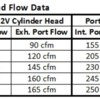quote:
Originally posted by tajon:
Would installing the new springs with the heads on the car change your recommendation for the springs being installed?
I would limit it to the Crane or PAC Racing springs, i.e springs with 1.82 inch installed height.
quote:
Originally posted by tajon:
Can any spring be installed if I do not pull the head?
Since machining the spring pedestals creates iron filings, I don't recommend machining the pedestals while the heads are mounted on the engine. Therefore your spring selection should be limited to springs with 1.82 inch installed height. This in turn limits your camshaft selection to flat tappet cams.
quote:
Originally posted by tajon:
Also if the rockers have different lift ratios 1.8 & 1.9 does that effect the spring selection?
The springs are limited to a specific amount of valve lift, regardless of the rocker arm ratio. The Crane spring is limited to 0.590 inch, the PAC Racing spring is limited to 0.605 inch lift.
The intake port airflow performance of unported 2V heads hits a brick wall at 0.400 inch lift, nothing to be gained with high ratio rocker arms.


